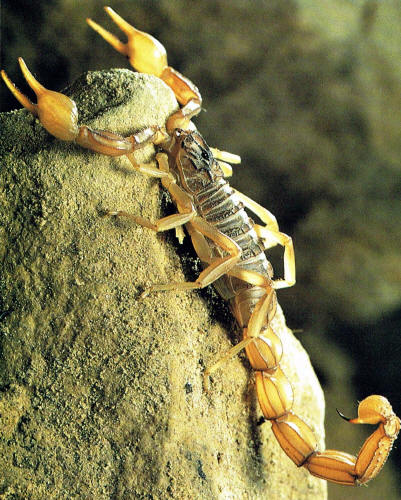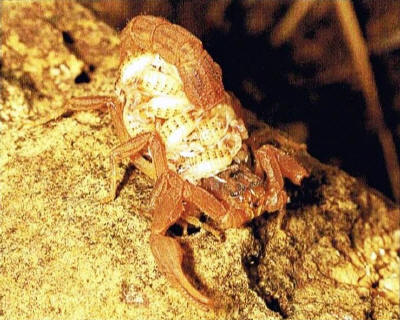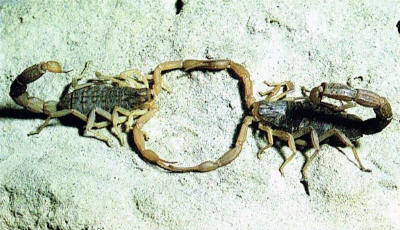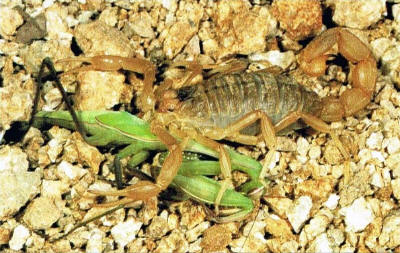|
Yellow-Tailed Scorpion

Scorpions are
aggressive hunters and are feared because of their stings,
which can be fatal in some species. Although deadly to its prey,
the sting of the yellow-tailed scorpion is harmless to humans.
Scorpions are found
throughout the world in warm and tropical countries,
though they are secretive and rarely seen. The yellow-tailed
scorpion, a relatively
harmless species with well-developed claws and a slender tail, is native
to Europe.
|
|

BREEDING
The male yellow-tailed scorpion initiates mating by
facing the female and grabbing her claws with his own.
As the two
circle each other, they raise their tails in the air. The male leads
the female, dragging her backwards and sideways.
The male then finds a patch of
suitably smooth ground and produces a capsule of sperm, called a
spermatophore,
which he attaches to the ground. Then he maneuvers the female over
the spermatophore, and she takes the sperm into her body. The male
quickly moves away, since the female can become very aggressive.
The fertilized eggs develop
slowly inside the female, and approximately a year later she gives birth
to 30 live young.

Once hatched,
the young climb onto their mother's
back
and remain with her for about a week.
PREDATORS
The yellow-tailed scorpion is
somewhat protected from predators by its sting. Still, it is often
eaten by birds, lizards and mammals.
Few invertebrates are capable of
overpowering a scorpion, although the praying mantis and a Mediterranean
relative of the black widow spider −the malmignette− do hunt them with
some success.
Yellow-tailed scorpions are extremely aggressive toward each other.
When two meet, they often fight to the death.
People have generally feared scorpions because of their sting and will
often kill them, whether they are poisonous or not.
|
HABITS
Scorpions hide during the day, usually in a damp spot
under a stone or log, and hunt at night. They sometimes find their
way into houses, where they hide in clothes, beds and carpets.
Scorpions have primitive eyes so they rely on their pincers to act as
sensory organs. The pincers are equipped with tiny hairs that
sense air and ground vibrations, so they transmit information about the
scorpion's surroundings and help it to detect both prey and predators.
The scorpion's sting is for defense and for killing small prey.
The yellow-tailed scorpion's sting is harmless to humans.

The mating
process can last for
several hours, or up to two days.
FOOD & HUNTING
The
yellow-tailed scorpion eats spiders, flies, moths and other insects.
It may actively hunt prey but often prefers to wait and seize an
unsuspecting insect with its pincers. When prey is large, the
scorpion will kill by arching its sting over its back and thrusting it
into the victim.
Scorpions have tiny mouthparts, so they
must break their prey into pieces with their pincers before eating.

A
yellow-tailed scorpion eats a large mantis.
DID YOU KNOW?
●
Male
and female scorpions are similar in appearance, but the male has a
narrower body and a longer tail.
●
After its first molt (shedding its skin), a baby scorpion is ready to
leave its mother. It molts seven to eight more times before becoming
an adult.
●
The largest member of the 800 species of scorpion grows as long as seven
inches.
●
Scorpions played an important part in the religious worship of the ancient
Egyptians.
●
In some cultures, certain species of scorpion are held in great respect
due to their powerful stings.
|


![]()
![]()